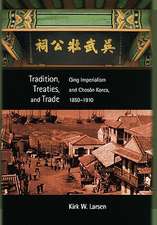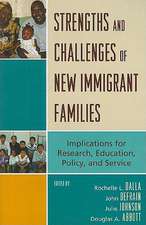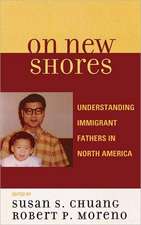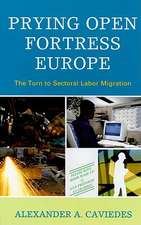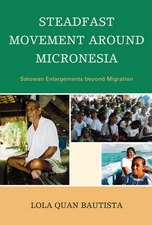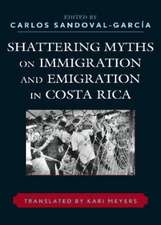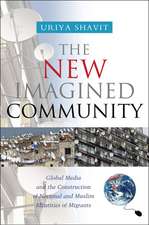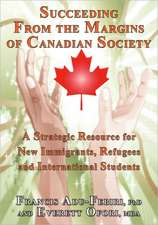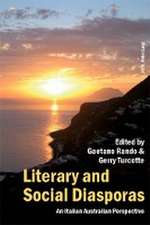Arrival City: How the Largest Migration in History Is Reshaping Our World
Autor Doug Saundersen Limba Engleză Paperback – 31 mar 2012
Vezi toate premiile Carte premiată
For the first time in history, there are now more people in the world living in cities than in rural areas, and many of them are clustering on the urban outskirts. Arrival City argues that this incredible movement of peoples, unfolding before our eyes, will be one of the most important trends in the twenty-first century. From Istanbul to Los Angeles, from Warsaw to Shenzhen, China, Doug Saunders shows how the success or failure of the immense communities forming on the fringes of traditional cities is having a profound effect on local, national, and international development.
Preț: 119.66 lei
Nou
Puncte Express: 179
Preț estimativ în valută:
22.90€ • 24.03$ • 19.00£
22.90€ • 24.03$ • 19.00£
Carte disponibilă
Livrare economică 21 martie-04 aprilie
Preluare comenzi: 021 569.72.76
Specificații
ISBN-13: 9780307388568
ISBN-10: 0307388565
Pagini: 384
Ilustrații: 1 MAP
Dimensiuni: 132 x 205 x 21 mm
Greutate: 0.3 kg
Editura: Vintage Publishing
ISBN-10: 0307388565
Pagini: 384
Ilustrații: 1 MAP
Dimensiuni: 132 x 205 x 21 mm
Greutate: 0.3 kg
Editura: Vintage Publishing
Notă biografică
Doug Saunders is an award-winning journalist and the European bureau chief of The Globe and Mail. He lives in London.
Extras
PREFACE
The Place Where Everything Changes
What will be remembered about the twenty-first century, more than anything else except perhaps the effects of a changing climate, is the great, and final, shift of human populations out of rural, agricultural life and into cities. We will end this century as a wholly urban species. This movement engages an unprecedented number of people—two or three billion humans, perhaps a third of the world’s population—and will affect almost everyone in tangible ways. It will be the last human movement of this size and scope; in fact, the changes it makes to family life, from large agrarian families to small urban ones, will put an end to the major theme of human history, continuous population growth.
The last time humans made such a dramatic migration, in Europe and the New World between the late eighteenth and the early twentieth centuries, the direct effect was a complete reinvention of human thought, governance, technology, and welfare. Mass urbanization produced the French Revolution, the Industrial Revolution and, with them, the enormous social and political changes of the previous two centuries. Yet this narrative of human change was not to be found in the newspapers of the 1840s or the parliamentary debates of the early twentieth century; the city-bound migration and the rise of new, transitional urban enclaves was a story largely unknown to the people directly affected by it. And the catastrophes of mismanaged urbanization—the human miseries and revolutionary uprisings and wars—were often a direct result of this blindness: We failed to account for this influx of people, and in the process created urban communities of recent arrivals who became trapped, excluded, resentful. Much of the history of this age was the history of deracinated people, deprived of franchise, making urgent and sometimes violent attempts to gain a standing in the urban order.
If we make a similar mistake today and dismiss the great migration as a negligible effect, as a background noise or a fate of others that we can avoid in our own countries, we are in danger of suffering far larger explosions and ruptures. Some aspects of this great migration are already unfolding in front of us: the tensions over immigration in the United States, Europe and Australia; the political explosions in Iran, Venezuela, Mumbai, Amsterdam, the outskirts of Paris. But many of the changes and discontinuities are not being noticed at all. We do not understand this migration because we do not know how to look at it. We do not know where to look. We have no place, no name, for the locus of our new world.
In my journalistic travels, I developed the habit of introducing myself to new cities by riding subway and tram routes to the end of the line, or into the hidden interstices and inaccessible corners of the urban core, and examining the places that extended before me. These are always fascinating, bustling, unattractive, improvised, difficult places, full of new people and big plans. My trip to the edge was not always by choice: I have found myself drawn by news events to the northern reaches of Mumbai, the dusty edges of Tehran, the hillside folds of São Paulo and Mexico City, the smouldering apartment block fringes of Paris and Amsterdam and Los Angeles. What I found in these places were people who had been born in villages, who had their minds and ambitions fixed on the symbolic center of the city, and who were engaged in a struggle of monumental scope to find a basic and lasting berth in the city for their children.
This ex-rural population, I found, was creating strikingly similar urban spaces all over the world: spaces whose physical appearance varied but whose basic set of functions, whose network of human relationships, was distinct and identifiable. And there was a contiguous, standardized pattern of institutions, customs, conflicts and frustrations being built and felt in these places across the poor expanses of the “developing” world and in the large, wealthy cities of the West. We need to devote far more attention to these places, for they are not just the sites of potential conflict and violence but also the neighborhoods where the transition from poverty occurs, where the next middle class is forged, where the next generation’s dreams, movements, and governments are created. At a time when the effectiveness and basic purpose of foreign aid have become matters of deep and well-deserved skepticism, I believe that these transitional urban spaces offer a solution. It is here, rather than at the “macro” state or “micro” household level, that serious and sustained investments from governments and agencies are most likely to create lasting and incorruptible benefit.
In researching this book, I have visited about 20 such places, in an effort to find key examples of the changes that are transforming cities and villages in far more countries. This is not an atlas of arrival or a universal guide to the great migration. Equally fascinating developments are occurring in Lima, Lagos, Cairo, Karachi, Calcutta, Jakarta, Beijing, Marrakesh, Manila. Nor is this book without precedent. Scholars in migration studies, urban studies, sociology, geography, anthropology, and economics have documented the phenomena described here, and many of them have generously assisted me with my work. But the larger message is lost to many citizens and leaders: the great migration of humans is manifesting itself in the creation of a special kind of urban place. These transitional spaces—arrival cities— are the places where the next great economic and cultural boom will be born or where the next great explosion of violence will occur. The difference depends on our ability to notice and our willingness to engage.
From the Hardcover edition.
The Place Where Everything Changes
What will be remembered about the twenty-first century, more than anything else except perhaps the effects of a changing climate, is the great, and final, shift of human populations out of rural, agricultural life and into cities. We will end this century as a wholly urban species. This movement engages an unprecedented number of people—two or three billion humans, perhaps a third of the world’s population—and will affect almost everyone in tangible ways. It will be the last human movement of this size and scope; in fact, the changes it makes to family life, from large agrarian families to small urban ones, will put an end to the major theme of human history, continuous population growth.
The last time humans made such a dramatic migration, in Europe and the New World between the late eighteenth and the early twentieth centuries, the direct effect was a complete reinvention of human thought, governance, technology, and welfare. Mass urbanization produced the French Revolution, the Industrial Revolution and, with them, the enormous social and political changes of the previous two centuries. Yet this narrative of human change was not to be found in the newspapers of the 1840s or the parliamentary debates of the early twentieth century; the city-bound migration and the rise of new, transitional urban enclaves was a story largely unknown to the people directly affected by it. And the catastrophes of mismanaged urbanization—the human miseries and revolutionary uprisings and wars—were often a direct result of this blindness: We failed to account for this influx of people, and in the process created urban communities of recent arrivals who became trapped, excluded, resentful. Much of the history of this age was the history of deracinated people, deprived of franchise, making urgent and sometimes violent attempts to gain a standing in the urban order.
If we make a similar mistake today and dismiss the great migration as a negligible effect, as a background noise or a fate of others that we can avoid in our own countries, we are in danger of suffering far larger explosions and ruptures. Some aspects of this great migration are already unfolding in front of us: the tensions over immigration in the United States, Europe and Australia; the political explosions in Iran, Venezuela, Mumbai, Amsterdam, the outskirts of Paris. But many of the changes and discontinuities are not being noticed at all. We do not understand this migration because we do not know how to look at it. We do not know where to look. We have no place, no name, for the locus of our new world.
In my journalistic travels, I developed the habit of introducing myself to new cities by riding subway and tram routes to the end of the line, or into the hidden interstices and inaccessible corners of the urban core, and examining the places that extended before me. These are always fascinating, bustling, unattractive, improvised, difficult places, full of new people and big plans. My trip to the edge was not always by choice: I have found myself drawn by news events to the northern reaches of Mumbai, the dusty edges of Tehran, the hillside folds of São Paulo and Mexico City, the smouldering apartment block fringes of Paris and Amsterdam and Los Angeles. What I found in these places were people who had been born in villages, who had their minds and ambitions fixed on the symbolic center of the city, and who were engaged in a struggle of monumental scope to find a basic and lasting berth in the city for their children.
This ex-rural population, I found, was creating strikingly similar urban spaces all over the world: spaces whose physical appearance varied but whose basic set of functions, whose network of human relationships, was distinct and identifiable. And there was a contiguous, standardized pattern of institutions, customs, conflicts and frustrations being built and felt in these places across the poor expanses of the “developing” world and in the large, wealthy cities of the West. We need to devote far more attention to these places, for they are not just the sites of potential conflict and violence but also the neighborhoods where the transition from poverty occurs, where the next middle class is forged, where the next generation’s dreams, movements, and governments are created. At a time when the effectiveness and basic purpose of foreign aid have become matters of deep and well-deserved skepticism, I believe that these transitional urban spaces offer a solution. It is here, rather than at the “macro” state or “micro” household level, that serious and sustained investments from governments and agencies are most likely to create lasting and incorruptible benefit.
In researching this book, I have visited about 20 such places, in an effort to find key examples of the changes that are transforming cities and villages in far more countries. This is not an atlas of arrival or a universal guide to the great migration. Equally fascinating developments are occurring in Lima, Lagos, Cairo, Karachi, Calcutta, Jakarta, Beijing, Marrakesh, Manila. Nor is this book without precedent. Scholars in migration studies, urban studies, sociology, geography, anthropology, and economics have documented the phenomena described here, and many of them have generously assisted me with my work. But the larger message is lost to many citizens and leaders: the great migration of humans is manifesting itself in the creation of a special kind of urban place. These transitional spaces—arrival cities— are the places where the next great economic and cultural boom will be born or where the next great explosion of violence will occur. The difference depends on our ability to notice and our willingness to engage.
From the Hardcover edition.
Recenzii
“A game changer. . . . Mightily researched, lofty and humane, Arrival City is packed with salient detail and could hardly be more timely.”
—The New York Times
“Arrival City presents an optimistic and humane view of global urbanization. Let’s hope urban planners and politicians pay attention.”
—The Wall Street Journal
“With the voice of a seasoned reporter, Saunders writes compelling, firsthand narratives describing the challenges and triumphs of migrant families from across the globe.”
—The San Francisco Chronicle
“Arrival City asks that we take a closer look at urbanization before its mismanagement is further mistaken for the thing itself, and to recognize that a citified future is not necessarily a doomed one.”
—NPR
“One of the year’s most engaging and important works of nonfiction.”
—The Independent (London)
“A timely contribution to the discourse on global cities. . . . Saunders offers a readable, immediate social history.”
—The Globe and Mail
“A brisk world tour of enormous urban-fringe neighborhoods populated by people who have left the countryside. . . . Perhaps because Saunders is a journalist who isn’t selling his advice, his version of the city is . . . more persuasive.”
—The New Yorker
“One does not need to be a cynic, alas, to suspect that cities and nations may not apply their best policies to their worst neighborhoods. But for those who are wise enough to try, Saunders has written the manual.”
—Bookforum
“Skilled in both colourful reportage and sustaining a good argument, [Saunders] provides a badly needed progressive and optimistic narrative about our future. . . . This may be the best popular book on cities since Jane Jacobs's The Death and Life of Great American Cities. . . . Few books can make rationalists feel optimistic and empowered for the future. [Arrival City] does.”
—The Guardian (London)
“Saunders’s approach is through anecdotes and vignettes, but . . . they cumulate into a persuasive whole. . . . Saunders’s practical suggestions for helping immigrants . . . are sure to attract attention. . . . [A] highly readable book.”
—Financial Times
“A masterpiece of reporting, one of the most valuable and lucid works on public policy published anywhere in years.”
—Edmonton Journal
“Important. . . . Saunders’s greatest strength lies in the global breadth of his reportage. . . . His evocative descriptions . . . transform a complex, serious subject into a page-turning read.”
—Literary Review
“A broadly researched, passionate and portentous call for a new way to look at the experience of migrants. It is essential reading . . . for all who look at the future of cities with a mix of hope and fear.”
—Winnipeg Free Press
“[An] incisive study of worldwide rural-to-urban migration, its complex social mechanisms and the consequences of institutional neglect. . . . An essential work for those who pay attention to the effects of globalization—which is, or at least should be, nearly everyone.”
—Kirkus Reviews
“Doug Saunders is neither a glum pessimist nor a glib optimist and Arrival City will not please closed minds. But this provocative, disturbing, and exhilarating book is a delight for thoughtful readers. Indeed, it is essential. Migration is reshaping the world and, as Saunders demonstrates, the choices we make today will determine whether it brings prosperity or catastrophe tomorrow.”
—Dan Gardner, author of The Science of Fear
“Arrival City is scarier than a dark urban fantasy and more gritty than the bottom of a demographer’s coffee cup. It’s also highly topical, as population growth and immigration are subjects of heated debate worldwide.”
—Daily Mercury
—The New York Times
“Arrival City presents an optimistic and humane view of global urbanization. Let’s hope urban planners and politicians pay attention.”
—The Wall Street Journal
“With the voice of a seasoned reporter, Saunders writes compelling, firsthand narratives describing the challenges and triumphs of migrant families from across the globe.”
—The San Francisco Chronicle
“Arrival City asks that we take a closer look at urbanization before its mismanagement is further mistaken for the thing itself, and to recognize that a citified future is not necessarily a doomed one.”
—NPR
“One of the year’s most engaging and important works of nonfiction.”
—The Independent (London)
“A timely contribution to the discourse on global cities. . . . Saunders offers a readable, immediate social history.”
—The Globe and Mail
“A brisk world tour of enormous urban-fringe neighborhoods populated by people who have left the countryside. . . . Perhaps because Saunders is a journalist who isn’t selling his advice, his version of the city is . . . more persuasive.”
—The New Yorker
“One does not need to be a cynic, alas, to suspect that cities and nations may not apply their best policies to their worst neighborhoods. But for those who are wise enough to try, Saunders has written the manual.”
—Bookforum
“Skilled in both colourful reportage and sustaining a good argument, [Saunders] provides a badly needed progressive and optimistic narrative about our future. . . . This may be the best popular book on cities since Jane Jacobs's The Death and Life of Great American Cities. . . . Few books can make rationalists feel optimistic and empowered for the future. [Arrival City] does.”
—The Guardian (London)
“Saunders’s approach is through anecdotes and vignettes, but . . . they cumulate into a persuasive whole. . . . Saunders’s practical suggestions for helping immigrants . . . are sure to attract attention. . . . [A] highly readable book.”
—Financial Times
“A masterpiece of reporting, one of the most valuable and lucid works on public policy published anywhere in years.”
—Edmonton Journal
“Important. . . . Saunders’s greatest strength lies in the global breadth of his reportage. . . . His evocative descriptions . . . transform a complex, serious subject into a page-turning read.”
—Literary Review
“A broadly researched, passionate and portentous call for a new way to look at the experience of migrants. It is essential reading . . . for all who look at the future of cities with a mix of hope and fear.”
—Winnipeg Free Press
“[An] incisive study of worldwide rural-to-urban migration, its complex social mechanisms and the consequences of institutional neglect. . . . An essential work for those who pay attention to the effects of globalization—which is, or at least should be, nearly everyone.”
—Kirkus Reviews
“Doug Saunders is neither a glum pessimist nor a glib optimist and Arrival City will not please closed minds. But this provocative, disturbing, and exhilarating book is a delight for thoughtful readers. Indeed, it is essential. Migration is reshaping the world and, as Saunders demonstrates, the choices we make today will determine whether it brings prosperity or catastrophe tomorrow.”
—Dan Gardner, author of The Science of Fear
“Arrival City is scarier than a dark urban fantasy and more gritty than the bottom of a demographer’s coffee cup. It’s also highly topical, as population growth and immigration are subjects of heated debate worldwide.”
—Daily Mercury
Premii
- Shaughnessy Cohen Prize for Political Writing Finalist, 2010



